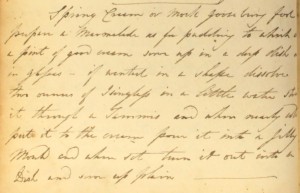The 19th century was the golden age of the gooseberry. Never was this little fruit so celebrated as in this era of gooseberry growing societies and county gooseberry shows. There was even a national publication dedicated to gooseberry cultivation – The Gooseberry Growers Register – and in 1845 it recorded as many as 171 gooseberry competitions across the country.
Gooseberries had long been used to add an acidic note to meat and fish dishes. Indeed, there’s a theory that the berry’s name comes from its pairing with roast goose. But in the late 18th and early 19th century, the falling price of sugar saw a boom in gooseberries’ popularity, and it became a common ingredient in puddings and desserts.
There was one hitch, however. Although they could be grown locally, the gooseberry season was short, peaking in June and July. Traditionally, the very first gooseberries are eaten around Whitsuntide, and the last of the crop arrive from the fields in August. How could the domestic cook sate their employers’ yearning for gooseberries the rest of the year, when there were simply none to be had?
The answer: rhubarb, the perfect ‘mock gooseberry’.
In this recipe for Spring Cream, rhubarb is cunningly disguised by first being reduced to a sweet jam. Once added to cream and set with gelatin, its sweet-sour taste would be all too easy to mistake for gooseberry!
Spring Cream or Mock Gooseberry Fool (19th century)
Prepare a marmalade as for pudding, to which add a pint of good cream. Serve up in a deep dish or in glasses. If wanted in a shape, dissolve two ounces of isinglass in a little water, strain it through a tammis and, when nearly cold, put it to the cream. Pour it into a jelly mould and when set turn it out into a dish and serve up plain.

